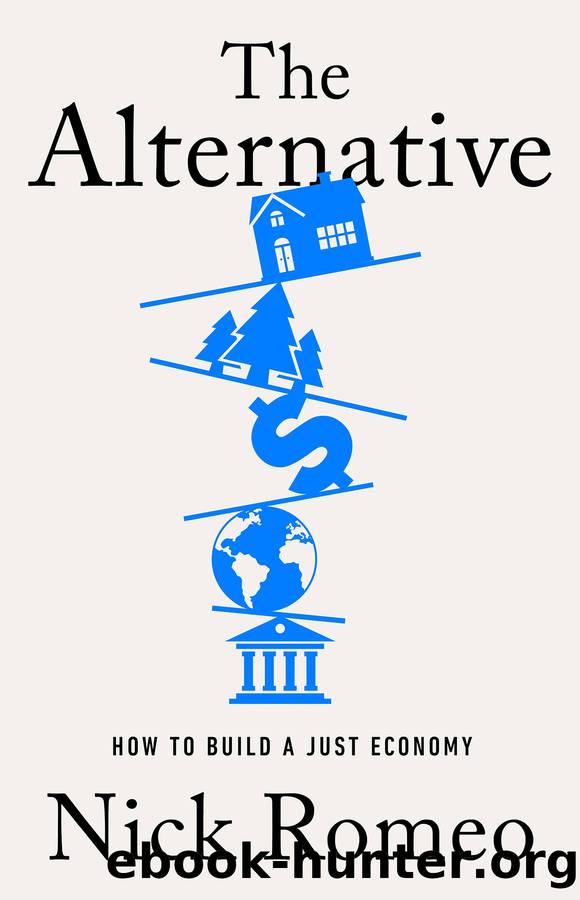The Alternative by Nick Romeo

Author:Nick Romeo [Romeo, Nick]
Language: eng
Format: epub
Publisher: PublicAffairs
Published: 2024-01-16T00:00:00+00:00
THE WORLDLY PRIEST
The town of Arrasate-Mondragón lies in a green river valley surrounded by the Cantabrian Mountains. Its two names reflect the regionâs linguistic and cultural duality: street signs, graffiti, and conversations are bilingual in Spanish (Mondragón) and Basque (Arrasate).
The center of the town of twenty-five thousand is a medieval city, with stone archways looming over narrow cobbled streets and a Gothic church in its central square. Traces of its long history are everywhere: the public library occupies a gorgeous old Franciscan monastery, while the local music school is in a former palace where the king of Spain is rumored to have spent the night in the Middle Ages.
On my first afternoon in Mondragón, Etxeberria and I walked into the dark interior of the church beside the central square. On one side of the shadowy central aisle lies the tomb of a twentieth-century priest named Don José MarÃa Arizmendiarrieta, who launched and shaped the Mondragon cooperatives. The sound of a choir rehearsing a hymn floated down from the loft. Etxeberria pointed to a stack of pamphlets beside the tomb of Arizmendiarrieta. I took one. It was part of a campaign to canonize the priest, described as âthe apostle of cooperation.â It included a suggested prayer to Arizmendiarrieta and information on whom to contact if it were answered. The Mondragon Corporation has no official position on the canonization campaign, but Arizmendiarrieta is venerated even among the secular. Back outside in the sun, Etxeberria told me, âThere are earthquakes, tsunamis, tornadoes, and there is Arizmendiarrieta. We are lucky he struck here.â
He almost didnât strike at all. After being captured by Francoâs troops in 1937 during Spainâs civil war, Arizmendiarrieta narrowly escaped execution. While working as a journalist for a Basque-language newspaper during the war, he frequently criticized the Nationalists led by Franco. After his arrest, according to one account, his interrogators spread his own articles before him on a table and demanded to know which he had written. Unwilling to lie, he settled for a partial truth, admitting authorship of harmless lifestyle pieces on rural Basque customs, but declining to mention that he had penned all the articles, including fiery denunciations of the regime that would have sealed his execution.
In 1941, the twenty-five-year-old priest was assigned to the town of Mondragón.4 The areaâs economy was deeply impoverished, and its society riven by the civil war. There was virtually no middle class. Roughly 90 percent of the population barely survived on low wages, and the other 10 percent was split between wealthy business owners and somewhat less affluent rural landowners.5 Over the next dozen or so years, Arizmendiarrieta mobilized the citizens to launch a raft of civic and cultural initiatives that would transform the region, including a technical school that became todayâs Mondragon University, a sports stadium, a medical clinic, and a housing complex for workers.
Perhaps most consequential was the Young Catholic Workers study circle he founded, with meetings held in a small, converted seventeenth-century palace that still stands in the old medieval town.
Download
This site does not store any files on its server. We only index and link to content provided by other sites. Please contact the content providers to delete copyright contents if any and email us, we'll remove relevant links or contents immediately.
International Integration of the Brazilian Economy by Elias C. Grivoyannis(92157)
The Radium Girls by Kate Moore(11935)
Turbulence by E. J. Noyes(7943)
Nudge - Improving Decisions about Health, Wealth, and Happiness by Thaler Sunstein(7622)
The Black Swan by Nassim Nicholas Taleb(7016)
Rich Dad Poor Dad by Robert T. Kiyosaki(6414)
Pioneering Portfolio Management by David F. Swensen(6231)
Man-made Catastrophes and Risk Information Concealment by Dmitry Chernov & Didier Sornette(5926)
Zero to One by Peter Thiel(5693)
Secrecy World by Jake Bernstein(4653)
Millionaire: The Philanderer, Gambler, and Duelist Who Invented Modern Finance by Janet Gleeson(4386)
The Age of Surveillance Capitalism by Shoshana Zuboff(4216)
Skin in the Game by Nassim Nicholas Taleb(4165)
Bullshit Jobs by David Graeber(4101)
The Money Culture by Michael Lewis(4083)
Skin in the Game: Hidden Asymmetries in Daily Life by Nassim Nicholas Taleb(3935)
The Dhandho Investor by Mohnish Pabrai(3706)
The Wisdom of Finance by Mihir Desai(3659)
Blockchain Basics by Daniel Drescher(3511)
